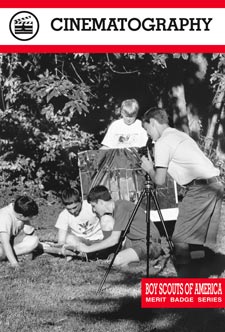The booklet shown above is the OLD booklet, and has been superseded.
- Explain and demonstrate the proper elements of a good motion
picture.
- Visual storytelling
- Rhythm
- The 180-degree axis rule
- Camera movement
- Framing and composition of camera shots
- Lens selection
- Discuss and demonstrate the proper elements of a good motion picture. In your discussion, include visual storytelling, rhythm, the 180-degree axis rule, camera movement, framing and composition of camera shots, and lens selection.
- Discuss the Cinematographer's role in the moviemaking process.
- Do the following:
- Tell In a three- or four-paragraph treatment, tell the story you plan to film, making sure that the treatment conveys a visual picture. in a three- or four-paragraph treatment. How does it read on paper?
- Prepare a storyboard for your motion picture (This can be done with rough sketches and stick figures.)
- Demonstrate six of the following motion picture shooting
techniques.
- Using a tripod
- Panning a camera
- Framing a shot
- Selecting an angle
- Selecting proper lighting
- Handheld shooting
- Do ONE of the following, using Using motion picture techniques,, plan ONE of the following programs. in
planning a program for your troop or school. Start with a
treatment, and complete the requirement by presenting the this
program to the a pack or your troop, patrol, or class.
- Film or videotape a court of honor and show it to an audience.
- Create a minifeature short feature of your own design using the techniques you learn learned.
- Film or videotape Shoot a vignette that could be used to train a new Scout in a Scouting skill.
- Do ONE of the following:
- With your parent's permission and your counselor's approval, visit Visit a film set or a television production studio and watch how production work is done.
- Explain to your counselor the elements of the zoom lens and three important parts.
- Explain the following jobs related to film or video production:
director, producer, cinematographer, key grip, gaffer, best boy,
assistant camera operator.
Find out about three career opportunities in cinematography. Pick one and find out about the education, training, and experience required for this profession. Discuss this with your counselor. Explain why this profession might interest you.
BSA Advancement ID#:
126
Requirements last updated in:
2008
Pamphlet Publication Number:
35869
Pamphlet Stock (SKU) Number:
35869
Pamphlet Revision Date:
2008
| Worksheets for use in working on these requirements: | Format | |
|---|---|---|
| Word Format | PDF Format | |
Page updated on: November 18, 2021









